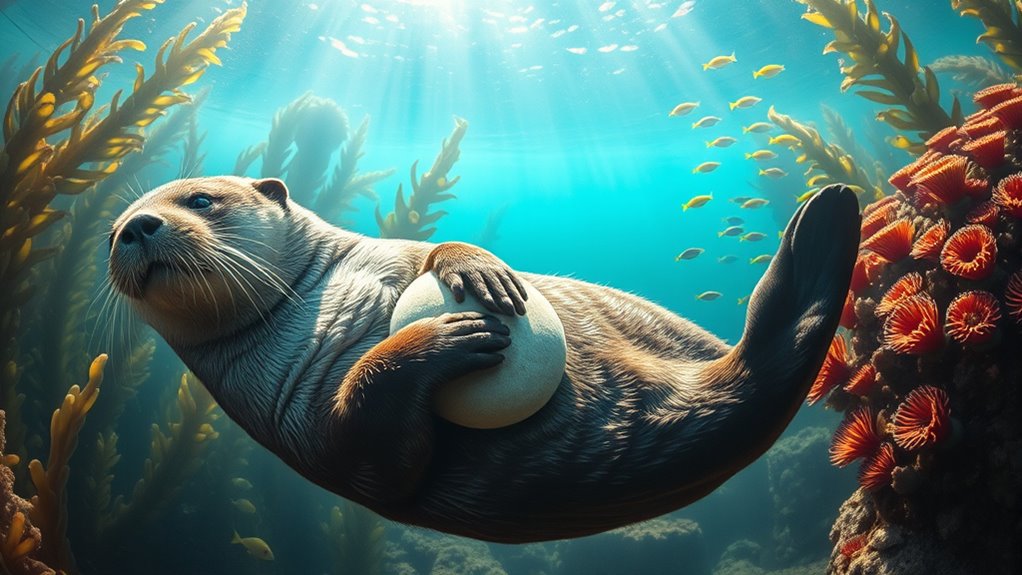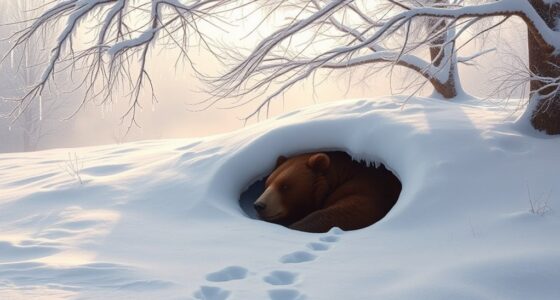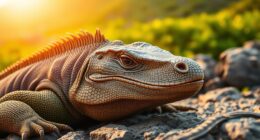The life of a sea otter is full of fascinating traits and behaviors. With the densest fur of any animal, they thrive in cold coastal waters by regulating their body heat. These playful creatures primarily dine on benthic invertebrates, consuming a quarter of their body weight daily. They nurture their pups with care, teaching them important survival skills. Unfortunately, threats like pollution and habitat loss loom large. Discover more about their critical role in marine ecosystems and conservation efforts ahead.
Key Takeaways
- Sea otters have the thickest fur of any animal, with up to 1,000,000 hairs per square inch, providing essential insulation in cold waters.
- They primarily inhabit coastal areas, thriving in rocky shores, kelp forests, and barrier reefs, with a historical range from Japan to Baja California.
- Sea otters consume 25% to 30% of their body weight daily, primarily feeding on benthic invertebrates like sea urchins, clams, and crabs.
- Female sea otters give birth to one pup every 1-2 years, relying on maternal care for grooming and teaching foraging skills for about six months.
- Conservation efforts include monitoring population health and advocating for policy changes to protect sea otters and their habitats from pollution and climate change.
Physical Characteristics of Sea Otters
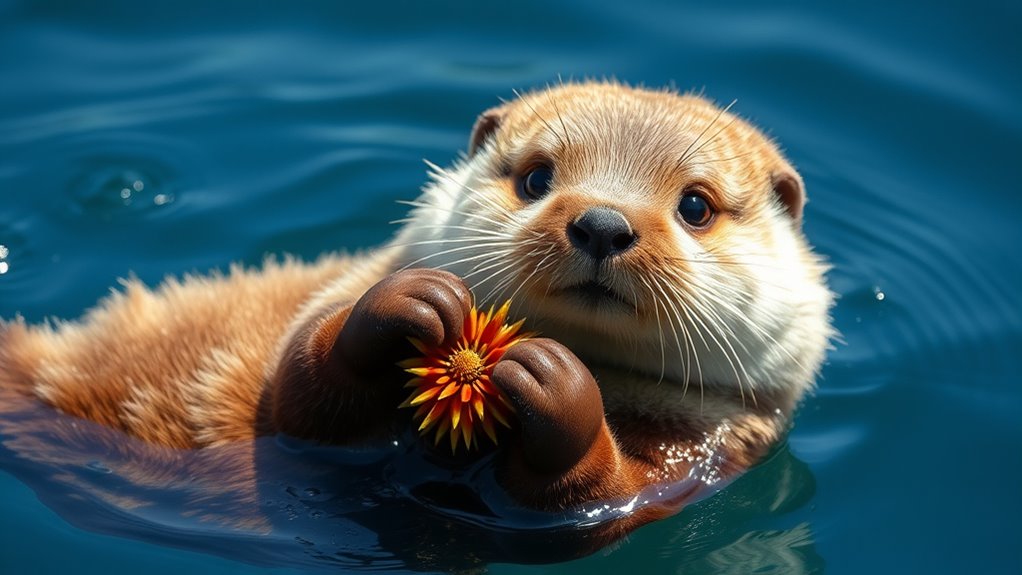
When you think of a sea otter, you might picture a fluffy creature gliding through the water.
These marine mammals have the thickest fur of any animal, boasting 850,000 to 1,000,000 hairs per square inch. This dense fur provides essential insulation, vital for survival in cold waters.
Adult males typically weigh between 65 to 90 pounds and measure about four to five feet long, while adult females are smaller, averaging 35 to 60 pounds.
Unlike other marine mammals, sea otters lack blubber; they rely solely on their fur to retain body heat.
Sea otters uniquely depend on their luxurious fur for warmth, as they lack the blubber found in other marine mammals.
Their unique physical adaptations include powerful forelimbs and flat, muscular tails, which enhance their swimming and foraging abilities, making them efficient hunters in their chilly habitats.
Habitat and Range
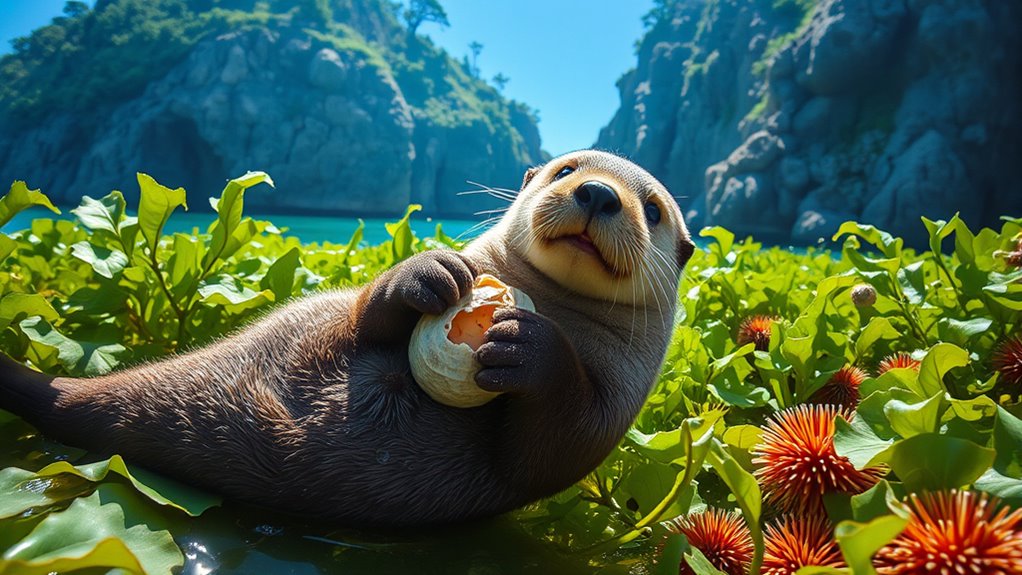
Sea otters thrive in coastal waters, usually staying close to shore within half a mile. You can find them in habitats like rocky shores, kelp forests, and barrier reefs.
Historically, their range stretched from Japan along the North Pacific coastline to Baja California, Mexico, supporting a population of up to 300,000 in the early 1700s. Today, the Southern sea otters are an endangered species, with around 3,000 individuals left in California and a global estimate of about 125,000.
Habitat loss due to pollution and climate change threatens their survival. Sea otters are crucial for maintaining the health of kelp forests, where they help control populations of marine invertebrates, fostering biodiversity in their coastal ecosystems.
Feeding Habits and Diet

Living in kelp forests and rocky shores, sea otters have developed unique feeding habits that allow them to thrive in their coastal environments.
These playful creatures primarily feast on benthic invertebrates, like sea urchins, clams, mussels, and crabs, consuming about 25% to 30% of their body weight daily to meet their high metabolic needs.
Using their powerful front paws and tools, such as rocks, they skillfully dislodge and crack open hard-shelled prey. In fact, a single sea otter can eat between 5,000 to 6,000 pounds of food annually.
This dietary specialization not only supports their survival but also helps regulate sea urchin populations, promoting ecosystem health and preventing overgrazing on kelp forests.
Reproduction and Pup Development
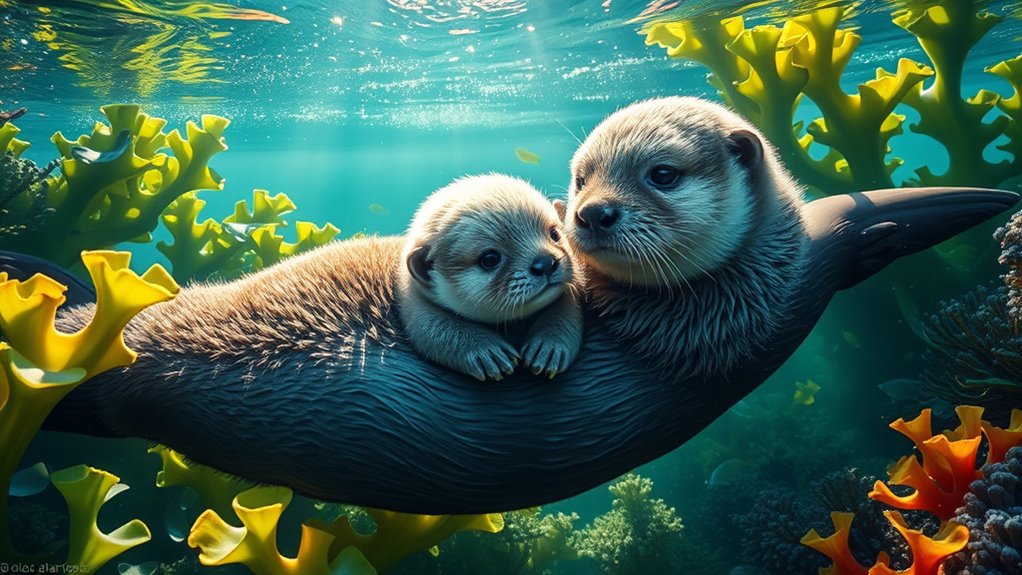
When a female sea otter gives birth, her pup is small and completely dependent on her for survival.
You'll find that for the first six months, the mother teaches her young one essential foraging skills while ensuring its fur stays clean and buoyant.
As the pup grows, it begins to explore its surroundings and learn to hunt independently.
Birth and Early Care
As sea otters welcome a new pup into the world, they commence on a journey of nurturing that's crucial for survival.
Female otters give birth to one pup every 1-2 years, with these little ones weighing between 3 to 5 pounds and covered in dense fur for buoyancy and warmth.
At birth, pups depend entirely on their mothers for food and protection, as they can't dive yet and are carried on their mothers' chests.
Maternal care is essential; mothers groom their pups' fur to maintain insulation and buoyancy. This care lasts around six months, during which pups start to be introduced to solid foods.
The nurturing environment allows them to develop important skills before they eventually grow into independence.
Learning Foraging Skills
While the nurturing bond between a mother sea otter and her pup is crucial, the real adventure begins as pups start learning important foraging skills.
During the first six months, these sea otter pups rely on their mothers for food supply and protection. Gradually, mothers introduce solid foods, teaching their young how to use tools for hunting.
As pups grow, they lose buoyancy due to thinning fur, allowing them to dive and explore. Their curiosity drives them to practice these skills, refining their technique.
Grooming plays a critical role in their development, keeping their fur insulated to regulate body temperature in chilly waters. This combination of learning and grooming prepares them for survival in the wild.
Threats to Sea Otters

Sea otters face numerous threats that jeopardize their survival.
Habitat loss, pollution, and human interference all contribute to their declining numbers.
Understanding these challenges is essential for their conservation and the health of marine ecosystems.
Habitat Loss
Habitat loss poses a significant threat to sea otters, driven by factors like pollution, climate change, and human activity.
The decline of kelp forests, essential for their habitat and food source, is largely due to climate change. When these important ecosystems diminish, sea otters struggle to find enough food.
Pollution from heavy metals, pesticides, and PCBs further degrades their habitats, leading to health issues and decreased food availability. Oil spills are particularly harmful, coating otters' fur and impairing their insulation, which causes hypothermia and starvation.
Additionally, coastal development and fishing practices disrupt their homes, increasing the risk of entanglement and mortality.
Protecting their habitats is imperative for the survival of these adorable marine mammals.
Pollution Effects
Pollution poses a grave threat to sea otters, impacting their health and survival in multiple ways. Heavy metals, pesticides, and PCBs introduce serious health risks, leading to compromised immune systems and increased mortality rates.
Oil spills are particularly devastating; they disrupt the insulating properties of sea otter fur, causing heat loss and heightening starvation risks. The 1989 Prince William Sound oil spill alone claimed around 2,650 sea otters.
Additionally, rising toxin levels in the environment can cause diseases like Toxoplasma gondii infections, contributing to declines in California sea otter populations.
Furthermore, pollution often leads to entanglements in fishing gear, resulting in accidental deaths and further threatening their recovery.
Protecting sea otters means addressing these pollution challenges head-on.
Human Interference
While many people admire sea otters for their playful nature, human interference has greatly threatened their survival. Historically, the fur trade decimated sea otter populations, dropping them from around 150,000 to fewer than 2,000 by the early 20th century.
Today, oil spills pose a critical risk, disrupting their fur's insulating properties and leading to hypothermia and starvation. Pollution from heavy metals and pesticides further complicates their health, increasing disease rates.
Accidental fishing gear entanglements also contribute to mortality, although a ban on gillnet fishing by the California Department has aided in slight recovery. Additionally, human activities can stress otters, affecting pup rearing and overall survival.
As a keystone species, their decline impacts the entire ecosystem.
Conservation Efforts and Future Outlook
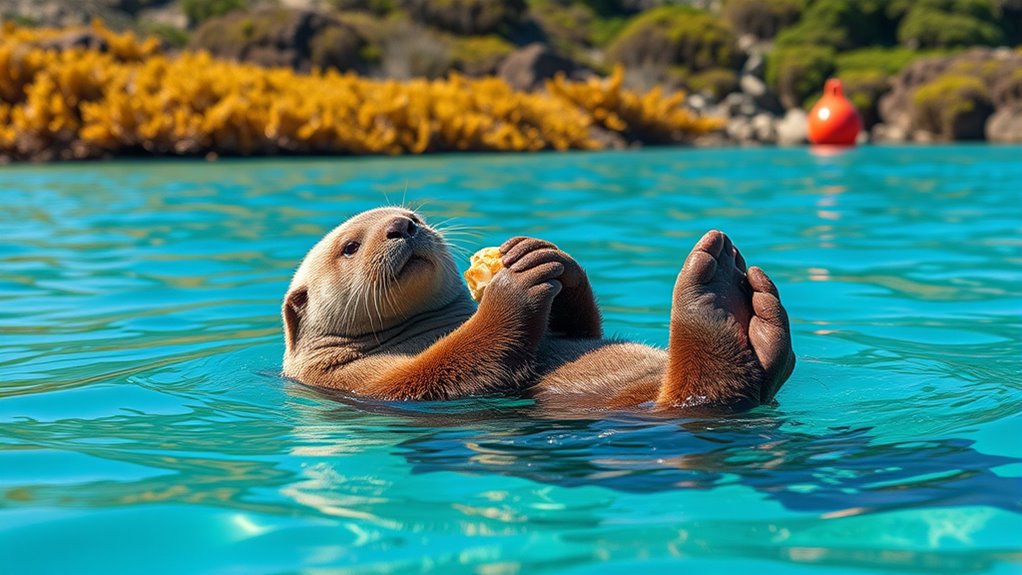
As sea otters face ongoing threats like oil spills and entanglement in fishing gear, conservation efforts have become more vital than ever.
Organizations like the Sea Otter Foundation Trust (SOFT) focus on research and education to protect California sea otters and their habitats. Thanks to these efforts, the population has risen to about 3,000 individuals, but it still lags behind historic levels, emphasizing the need for continued support.
Collaborations among agencies such as the U.S. Fish & Wildlife Service and the California Department of Fish & Wildlife are important for monitoring sea otter health and conducting annual censuses.
Public engagement through donations and education campaigns boosts awareness of the ecological importance of sea otters, ensuring a brighter future for these remarkable creatures.
Frequently Asked Questions
What Is the Lifecycle of a Sea Otter?
The lifecycle of a sea otter starts when a female gives birth to a pup, usually every 1-2 years after a six-month gestation.
At birth, pups weigh around 3 to 5 pounds and rely on their mothers for about six months. As they grow, they learn to dive and explore while still needing maternal guidance.
What Is the Lifestyle of a Sea Otter?
When you think about the lifestyle of sea otters, you picture them as social creatures, often seen in rafts.
They spend most of their time grooming their thick fur to stay warm, which is essential for their survival.
You'd notice how they forage for food like crabs and sea urchins, consuming a quarter of their body weight daily.
While males tend to be solitary, females often gather with their pups for protection and support.
What Are 5 Interesting Facts About Sea Otters?
You'll find sea otters fascinating for several reasons.
First, they've the densest fur of any animal, with up to a million hairs per square inch!
Second, they consume 25% to 30% of their body weight daily, mostly feasting on invertebrates.
Third, they use tools like rocks to crack open shells.
Fourth, they're essential for maintaining healthy kelp forests by controlling sea urchin populations.
Finally, females give birth to just one pup every 1-2 years!
What Is the Daily Life of an Otter?
Imagine gliding through the waves like a playful spirit; that's what a day in an otter's life feels like.
You'll spend most of your time foraging, diving deep for tasty treats, and munching on your finds. When you're not hunting, you'll groom your luxurious fur to keep it warm and buoyant.
You might even join your friends in a cozy raft, resting while keeping an eye on the little ones nearby.
Conclusion
In the grand tapestry of marine life, sea otters weave a vibrant thread, showcasing their charm and significance. By understanding their physical traits, habitats, and feeding habits, you gain a deeper appreciation for these playful creatures. Yet, as they face threats from pollution and habitat loss, it's vital you support conservation efforts. Together, you can help guarantee that future generations continue to marvel at the sea otter's joyful dance among the waves.
